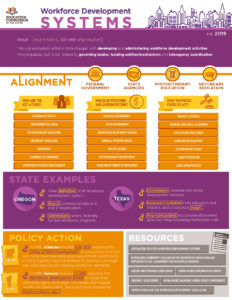Over the last month we explored the how of workforce development, but what motivates states to act?
Recent reports suggest that if certain educational and training gaps aren’t filled, there is the potential to lose $1.7 trillion in economic productivity by 2030. The numbers are compelling; however, workforce development activity, programs and policy within a state are primarily driven by actions from state leaders and stakeholders. As discussed in our past blog posts, federal policy serves as a base motivator for states to organize and engage in workforce development; however, additional motivators — such as governor priorities, legislative action, attainment goals and the need to connect education to workforce needs — serve as motivators behind workforce development in states.
Governor Priorities
Leadership around workforce development comes in many forms, and governors play a role in prioritizing it — specifically by aligning both workforce and economic development in their priorities and agendas. Earlier this year, 35 governors prioritized workforce development in their State of the State addresses.
Gov. Roy Cooper of North Carolina created NC Job Ready. Through his leadership and collaboration among workforce stakeholders, the initiative provides people with opportunities to pursue education and training that will allow them to access jobs in high-demand fields. The initiative offers 34 career pathways for individuals that align education and training with skills needed in high-demand fields.
Legislative Action
Outside of governor’s leadership, legislatures support and retain individuals pursuing workforce education and training aligned with fields central to the economic growth of the state. This year, North Dakota passed H.B. 1171, creating and appropriating funds for the Skilled Workforce Loan Repayment Program and the Skilled Workforce Scholarship Fund. To be eligible for either program, individuals must complete an educational program in a high-demand field as identified by the department of higher education and workforce development council. Recipients must reside in the state and work in the high-demand field.
Postsecondary Attainment Goals
At least 44 states have established attainment goals and state plans. An increasing number of states are considering ways to connect attainment goals with workforce needs and industries that drive economic growth in their state.
For example, Iowa, through its Future Ready Iowa initiative, connects workforce and economic development needs with an attainment goal. Through the initiative, Iowa set a goal to have 70 percent of the workforce with education and training beyond high school by 2025. The initiative supports pathways for both high school students and adults to access education and training that lead to a credential. The goal is to build Iowa’s talent pipeline and provide people with an opportunity to gain education and training to earn a living wage in a high-demand field.
In an ever-evolving economy, state leaders and workforce stakeholders are motivated to find ways that connect economic growth, workforce development and postsecondary attainment. Beyond creating a trained workforce, states work to retain talent and place individuals in high-demand fields. Through strong leadership and a willingness to align economic and workforce development needs, states can create a future that has a trained and educated workforce that drives their economy.
















